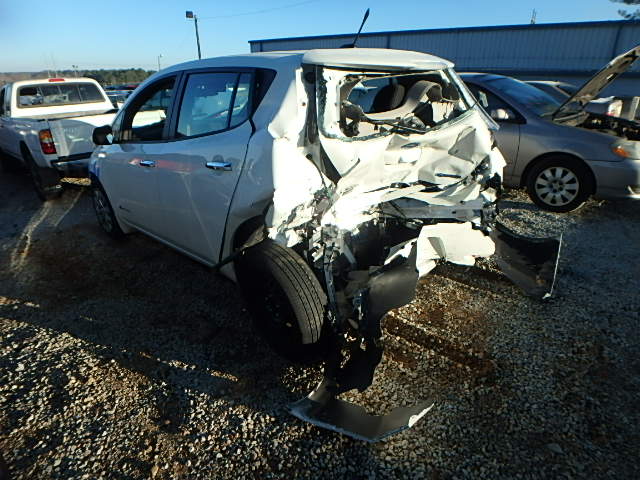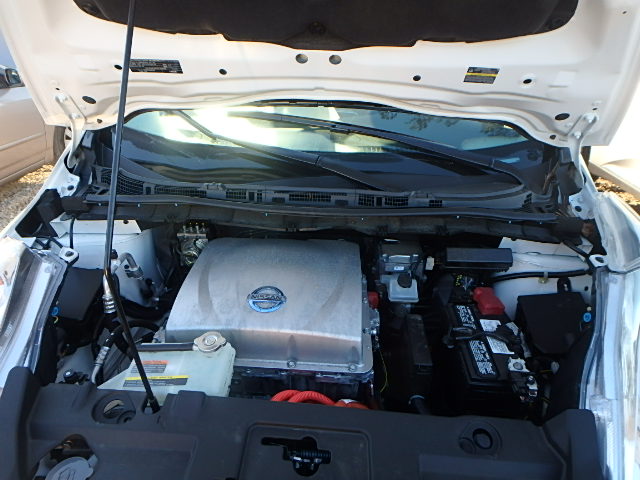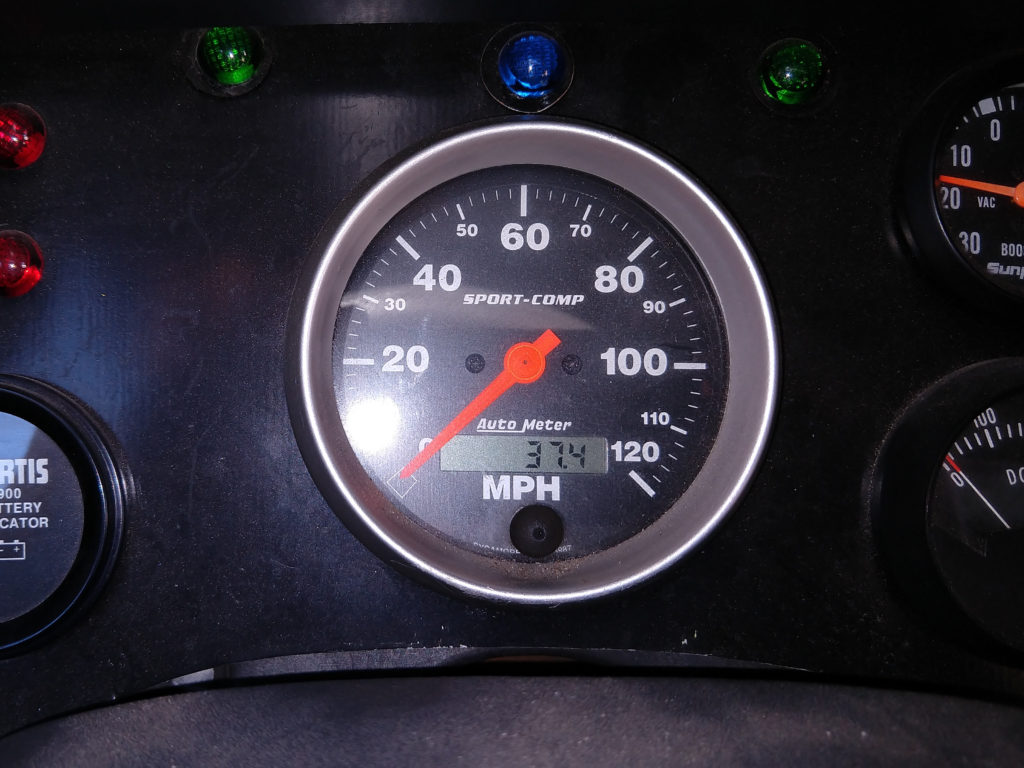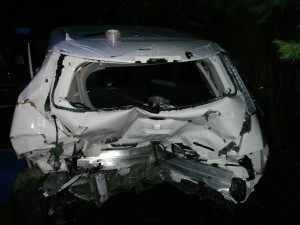This is Hoja, a new (to me) 2013 Nissan Leaf. Hoja was rear-ended sometime around December or January, and was “totaled” by his insurance company, The Travelers Indemnity Company. They used Copart, an auto-auction company to sell the remains with a salvage title.
I purchased Hoja just to obtain the LiIon modules in the battery pack, and was happy to find that the dash console reports that the battery has the full 12 bars of capacity, even though he has almost 19K miles under his tires. I may also be able to use a few other parts such as the J1722 charging port (and possibly the built in charger…), but the majority of the car will be junk sitting in my back yard until I can get rid of it.
My hope is that I will be able to sell many parts from the car to help reduce the overall purchase price, and in this respect I think I am lucky that the majority of the damage was to the rear end, in that the motor/inverter/charger and front mechanical systems look to be in good shape. (Update: I’ve sold everything from the car, sorry.)
Details about the purchasing process
In Georgia, due to good lobbying by the established auto industry players, only licensed “auto brokers/dealers/dismantlers” can purchase used cars at the Copart auctions, but private individuals (with some cash) can purchase cars with a Salvage title. All you need is a web browser, and an established account on copart.com.
Note to potential buyers: You will want to set up your account with Copart several days before the first auction you want to bid on. They require that you send them a copy/scan of your drivers license (before you can bid). It takes a few days to process, so don’t leave it to the last minute.
You will also need to pay them a 10% deposit. For example, if you want to be able to bid up to $5,000, you need to pay a $500 deposit. The deposit can be applied to your final purchase (by calling their customer service agents) or simply refunded to your credit card after the fact using their website.
Then, all you have to do is search for the type of auto you want (making sure it has a salvage title, unless you are a licensed auto broker/dealer/dismantler, etc) and place a bid.
Note that the bids you place on the Internet before the day of the auction just sets the “starting bid” at the actual physical auction, so even if you are “winning” the bid, you are not likely to win the car unless you watch and bid in the “live” auction (unless you bid so much that nobody at the live auction will go over your maximum bid amount).
Some cars are sold on a “pure sale” basis, which means that the highest bid will win the car. Most of the Leaf auctions that I watched were listed as “on approval” which means that even if you win the auction, the insurance company (seller) has the final say if they want to accept the cash for the car, or if they want to keep the car and try re-listing it at a later auction.
(I had one auction where I won the bidding but the maximum offer was not accepted by the insurance agency seller.)
My tips for finding a cheap Nissan Leaf (for the battery pack):
- Look for the most damaged car you can find. The more expensive it will be to repair, the less likely somebody else wants it. The battery is relatively well protected from front/rear collisions, and should hopefully still be good.
- Cars with multiple points of damage (front and back, or rollover) are a good bet. Any car with “Biohazard” as a secondary damage type (e.g. blood) also tend to sell for a lower price.
- Look for cars with a low initial bid on the Internet the day of the auction. (This may be a reason to NOT bid before the live auction!)
- Keep a watch on all of the leafs, and if possible, watch the live auctions to get a feel for the prices that they sell for so you know what a “good” price is.
- Know your maximum price point. Use a spreadsheet to calculate to total cost including all fees (see below). Compare this to buying new LiIon cells from your favorite distributer. Consider the extra labor costs involved in removing the pack from the car and the modules from the pack and re-packaing them into the form you need. I ended up paying about 15% of the cost of used Leaf (2011/2012) modules purchased on the Internet, but this took a LOT of work selling parts from the car piecemeal.
- When you see a car at a good price, bid aggressively (e.g. as soon as possible after somebody else bids) until you reach your maximum price point. The faster you match/counter an opponents bid the more they may think you are willing to keep incrementing the price until you get it and back away.
- Don’t be in a hurry! I watched and bid on leaf auctions for around two months before I won Hoja at a good price.
To give you an idea of the average selling price of a salvage Nissan Leaf (in Atlanta in the spring of 2015), here are some numbers I collected while watching Leaf Auctions:
- These are auctions where I actually saw the live auction final ending price:
- 2015 Leaf, front collision damage: $5400
- 2014 Leaf, side damage, 11K miles: $7200
- 2015 Leaf, lots of front damage, 2K miles: $4200
- 2015 Leaf, moderate front end damage: $6500
- 2015 Leaf, “run and drive”, with rollover/biohazard damage: $7000
These are auctions where I did not see the live auction ending price, but I did record the highest “pre-bid” on the Internet, so the final price was at least as high as these numbers, and most likely higher:
- 2015 Leaf, front/side damage + biohazd: $4650
- 2013 Leaf, side damage, 11K miles: $6600
- 2015, all over damage, biohazrd: $4750
- 2013 Leaf, not to bad damage, pure sale: $4750
- 2015 Leaf, Side impact damage: $6400
Note that the final bid price is NOT a full reflection of the actual cost, because CoPart adds a good number of fees and taxes (plus a delivery charge). Pay special attention to all of the fees, such as a secured funds fee of $400 on any car in the 3-5K range, (it costs more if you pay with a credit card instead of a wire transfer) an “Internet bid fee” of $79, A gate fee of $50, and a delivery fee (for me) of $135.
After San Francisco, the Atlanta area is the 2nd best place to buy a used/salvage Leaf, and I was lucky in that CoPart has 3-4 auction sites all around the metro area with relatively inexpensive delivery costs to my location.
Of course, you are buying a “used” battery pack, and it will take a lot of labor to make it usable (unless you are putting it into another Leaf) for your EV project, so you want to buy your car for no more than $4000-4500 total cost.






What do you do with the rest of the car? I’ve not found a local salvage yard that will take a used Leaf. They told me they have no calls for parts for them and would rather use their limited storage space for cars with more demand for parts.
I have not even dropped the pack yet, so I haven’t had to deal with the issue of getting rid of the car. My plan is to strip any parts that I can sell on Ebay (headlights, airbags, computer modules, other small parts) and/or locally (doors, glass, seats, wheels/tires) to try and recoup some of the cost.
But yes, since most Leaf’s are still under warranty and/or full insurance coverage, there may not be a great demand for used spare parts just yet. Regardless, the price I paid made the pack economical even if I can’t sell any parts. Worst case scenario, I figure I can get a junk car guy to haul it away for free, or possibly pay me a few hundred dollars just for the scrap steel.
Interested in buying the 2 front seats. Looking for cheap. I want them for my Geo Metro. I love the seats in my 2012 leaf so much I want to see about getting a set for my little metro 🙂
any idea what that would cost? especially shipping? 19057
The front drivers seat is bent from the crash. I’ve sat in it, but I don’t know if you would want it for your car. It still has the side airbag and seat heater in it however… I’m asking $100 for that one, and $200 for the passanger seat which is in good condition. Both have airbags and seat heaters in them. Shipping would probably be in the hundreds of dollars range…probably have to go freight. It might be worth your time for a weekend road trip to pick them up.
The steel entire body of the auto is always worth one thing, even if it is
getting scrapped. When looking to sell your junk car,
it is a good idea to first establish ownership of the vehicle, as many companies that buy junk cars only do so from titleholders.
I’m also interested in a Leaf battery, do you think you could get me one? I am in the Caribbean.
Sorry, I’m not interested in work as an exporter.
Did you ever get through with the pack?
Yes, I converted it into a 120v battery for my S-10 pickup conversion and drove that for several years. This link has some of the videos on it:
https://www.summet.com/blog/leaf-truck/
Or, search for the “leaf” tag on the blog to see all the posts:
https://www.summet.com/blog/tag/leaf/
Nice stuff. I bought my Leaf belly out of Niagara Falls for $2400; two years ago. Probably prices have gone up. I’m using them in an electric boat.
Are there any synchronous motors in the 2kw and up range in a Leaf? Something that could be used in an ebike or a canoe? I’m not an electronics wizard, and would want something with the controller attached, with switches, with speed control, etc. In these modern days of failsafes, it gets really complicated really fast….
To the best of my knowledge, the only motors on the leaf that use the full pack voltage are the main drive unit, and the compressor for the AC/HVAC system. Everything else is a standard automotive 12 volt system. The HVAC system motor is relatively small, so I don’t think it would work for an ebike application.
Jay I was thinking of using leaf batteries in my electric cabin cruiser instead of replacing my 10 x 6v lead acid golf cart batteries, do you have any tips for me about doing this?
Thanks Brian
Leaf cells will definitely be lighter and take up less room, but you may need to change out your charging infrastructure. To charge LiIon batteries the charger must be able to stop charging at a maximum voltage, and it should ideally also have a way to be turned off by a BMS system if any single cell voltage gets too high. So plan on using a BMS system with your leaf modules and making your current charger listen to the BMS system for an emergency shutoff of charging if the pack gets out of balance.
10 x 6volts = 60 volts. The closest you can come with leaf modules (8v nominal) is 56 or 64 volts (7 or 8 in series), but unless your motor controller / charger are very picky that should be close enough. You’ll probably want to have a few sets in parallel (I have sets of 3 in parallel to get 120 Ah). If you buy a full leaf battery worth of modules (48) you can do eight series set of six cells in parallel (to use all 48), which would give you 360 Ah of capacity at 64 volts.
Pingback: J1772 to 120 volt opportunity charging auto-switchover | Jay's Technical Talk
Looking to power mining stuff, possible fish farm. Clark county NV, think a Leaf would be too much. Anyway will check home state WI for a crashed Leaf
Remember the main battery component that powers the leaf is around 650lbs. Its large and relatively flat. Look at at the schematics on the car.
My 2012 nissan leaf was just declared total loss. Adjustor offering $1500 less than i owe on the car. Salvage offer and parting the car out myself may allow me to be more flush with what is owed.
The car had 28,000 miles and charged to full 11 bars which is rare after a few years of ownership but i was extremely careful in how i charged the vehicle to assure it maintained full capacity life longer. Email if interested. This was a fully loaded SV model with additions like solar cells on back spoiler to add to additional lower accessory 12 v. Battery. Also had dual ports for rapid charge and level 1,2 and 3. Again those were additions in the 2012.
Hi Kimberly,
Just wonder if you still have the Nissan Leaf? Please email me if you do, thanks. My email is Calvin_Cao@hotmail.com
Do you know if we can buy new leaf battery modules somewhere?
Not on the consumer market, but if you were buying enough of them I’m sure you could negotiate with Nissan’s supplier.
You can buy recovered leaf packs (from salvage cars) from Hybrid Auto Center in Nevada.
I’m looking to get a pack from a 2015 into my 2012. I know Nissan says they’re incompatible but what are your thoughts about getting the 30 kWh pack from 2016 SV/SL into the earlier models? They’re apparently the same size, just higher density…
They will have slightly different wiring connections, and unless you can hack the firmware of the BMS inside the newer battery, it won’t work in your car. What you MAY be able to do is to open up both packs and (carefully, very carefully) swap out all of the modules from the new pack to the old pack (if they are physically the same size), keeping the BMS and connections from the old pack.
I know of somebody who has transplanted modules from a 2015 to 2012 pack, but I don’t know if the modules in the 30kWh pack are the same physical size.
I’m looking to power a golf cart. 36v. With plenty of reserve power any cells for sale? Charger? 3056192536
I’m afraid that I do not have any cells for sale (I used all I had in my truck).
Check out this link for a company (Hybrid Auto Center) that has been around for a few years that sells turn-key solutions for golf carts:
https://evbatterycenter.com/
Jay
Hi an looking for a Nissan Leaf battery’s
I don’t have one to sell, but perhaps somebody else who does will see this and contact you.
I’d like to know what a fair price is for a 2013 Leaf battery is as salvage, if you don’t mind saying. My application is not mobile.
Somewhere between $1,000 and $4,000 would be my opinion. A 2013 battery is getting a bit long in the tooth in that the cells may be significantly degraded (but for non-mobile applications, you may not care that you only get 12-16 kWh out of a pack). I personally would be looking to pay $2,000 or less for a pack of unknown quality, perhaps up to $2,500 for one with some type of leafspy or BMS report as to the cell quality. But then again, I’m cheap. If a seller is offering one in the $3,000-$4,000 range I wouldn’t look askance at it, but wouldn’t pay that much myself.
Pingback: Salvage 2013 Nissan Leaf modules – 7 year old range update | Jay's Technical Talk
Jay,
I enjoyed reading the material you’ve posted. Thanks. I have been considering doing an electric boat project and have been doing some research. I like the Leaf platform and have a few questions. Why did you not use the leaf BMS in your electric truck project? It appears that there are various tools (canbus sniffers, opensource software, etc.) to access the canbus and monitor/manipulate the data to achieve your desired outcome. With regards to buying a project leaf, do you still recommend using the online salvadge website? I’m in Spartanburg, SC so I have access to the Atlanta/Charlotte/Asheville, Columbia markets. I am a little hesitant to purchase one without being able to put my eyes on it. Do you recommend using the Coparts site or are the third party sites pretty much the same with regards to purchasing a salvadge? In today’s market, which model do you consider to be the best value for a project?
Thanks,
I needed to re-wire my pack for 130 volt operation as my existing DC motor / controller max out at 140 volts, so I could not make use of the built in Leaf BMS. If you have a motor/controller that operates at the higher voltages (up to 400v) of the Leaf Pack, keeping it unmodified would be a good solution (if you can fit it into your project space).
I had good luck with CoPart, but can’t compare it to any others as I only bought the one Leaf.
If you are just looking to salvage the battery, look for a car with as much damage as possible (rollover with front/back damage would be best) so that it’s value to others will be low. Generally the battery is better protected than just about anything else in the car. A 2015 or newer is more likely to have the better “lizard” chemistry and not be too degraded due to age.
Thanks for the input. I’m still in the research phase and haven’t purchased any components yet. The current requirements for the project are a motor in the 80 to 150 range and ideally, control systems that can be interfaced to function as a propulsion system for a boat. My thought was that I would have the most flexibility in hardware and functionality if I can access the canbus and understand the traffic in order to make the system operate in a more effecient manner. I was attracted to the Leaf because it has the motor/controller/inverter/charger all physically mounted together, and it appears that there is a fair amount of information on modifications/projects for the leaf.
I would like to do this for ~$5k. Any thoughts?
If you are able to physically fit the Leaf motor/inverter and battery in your boat, using the complete system would certainly make things simpler. If you harvested everything from the car it would be possible to use the cars existing control system, although it may be easier to use some of the 3rd party boxes that control the motor/battery separately. I suspect you will spend ~5k for the salvage leaf, but need a bit more for all of the other things you’ll need (brackets, mounting hardware, control systems, etc…) Plus a lot of work.
Thanks
Pingback: Salvage 2013 Nissan Leaf Modules – 8 year age capacity test: 75-80% | Jay's Technical Talk